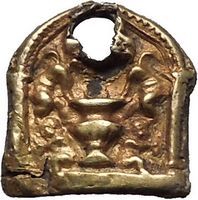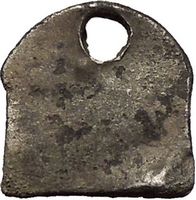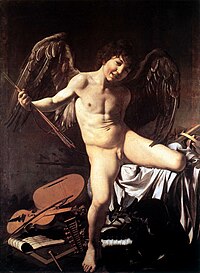|
Roman Silver Gold Plated Application Turned into Jewelry
Artifact with Cupids
Circa 50-150 A.D.
1.5 x 0.9 centimeters (2.37 grams)
Two cupids stand on top of two children, lifting up a a giant
kantharos (wine mixing vessel). It is apparent that this was worn in ancient
times as a piece of Jewelry. It is interesting because it brings up imagery of
Cupid, the son of Venus and the wine drinking symbolism of Bacchus, the Roman
equivalent of Dionysus.
Provenance: From
private collection in the United States of America.
Ownership History: From
private collection in the United States, bought in private sale in the United
States of America.
You are bidding on the exact item pictured,
provided with a Certificate of Authenticity and Lifetime Guarantee of
Authenticity.
_with_Female_Head_-_Walters_482763_-_View_A.jpg/260px-Greek_-_Red-Figure_Kantharos_(Drinking_Vessel)_with_Female_Head_-_Walters_482763_-_View_A.jpg) A
kantharos or cantharus is a type of
Greek pottery used for drinking. In its iconic
"Type A" form, it is characterized by its deep bowl, tall pedestal foot, and
pair of high-swung handles which extend above the lip of the pot. The Greek
words kotylos (κότῦλος, masculine) and kotyle (κοτύλη, feminine)
are other ancient names for this same shape. A
kantharos or cantharus is a type of
Greek pottery used for drinking. In its iconic
"Type A" form, it is characterized by its deep bowl, tall pedestal foot, and
pair of high-swung handles which extend above the lip of the pot. The Greek
words kotylos (κότῦλος, masculine) and kotyle (κοτύλη, feminine)
are other ancient names for this same shape.
The kantharos is a cup used to hold
wine, possibly for drinking or for
ritual use or
offerings. The kantharos seems to be an
attribute of
Dionysos, the god of wine, who was associated
with
vegetation and
fertility.
It may not be a banquet-cup, but rather a vessel used in pagan cult as a
symbol of
rebirth or resurrection, the
immortality offered by wine, "removing in
moments of ecstasy the burden of self-consciousness and elevating man to the
rank of deity."
In
Roman mythology,
Cupid (Latin cupido,
meaning "desire") is the god of desire, affection and
erotic
love. He is often portrayed as the son of the goddess
Venus, with a father rarely mentioned. His
Greek counterpart is
Eros. Cupid is also known in Latin as Amor ("Love"). The
Amores (plural) or amorini in the later terminology of
art history are the equivalent of the Greek
Erotes.
Although Eros appears in
Classical
Greek art as a slender winged youth, during the
Hellenistic period he was increasingly
portrayed as a chubby boy. During this time, his iconography acquired the bow
and arrow that remain a distinguishing attribute; a person, or even a deity, who
is shot by Cupid's arrow is filled with uncontrollable desire. The Roman Cupid
retains these characteristics, which continue in the depiction of multiple
cupids in both
Roman art and the later
classical tradition of
Western art.
Cupid's ability to compel love and desire plays an instigating role in
several myths or literary scenarios. In
Vergil's
Aeneid, Cupid prompts
Dido to fall in love with
Aeneas, with tragic results.
Ovid makes Cupid the patron of love poets. Cupid is a central
character, however, in only the traditional tale of
Cupid and Psyche, as told by
Apuleius.
Cupid was a continuously popular figure in the
Middle Ages, when under Christian influence he
often had a dual nature as Heavenly and Earthly love, and in the
Renaissance, when a renewed interest in
classical philosophy endowed him with complex allegorical meanings. In
contemporary popular culture, Cupid is shown shooting his bow to inspire
romantic love, often as an icon of
Valentine's Day.
Legend
In the Roman version, Cupid was the son of Venus (goddess of hope) and Mars
(god of war).[2][3]
In the Greek version he was named
Eros and seen as one of the
primordial gods (though other myths exist as
well). Cupid was often depicted with wings, a bow, and a quiver of arrows. The
following story of
Cupid and Psyche is almost identical in both
cultures; the most familiar version is found in the
Metamorphoses of
Apuleius. When Cupid's mother Venus became
jealous of the princess
Psyche, who was so beloved by her subjects that
they forgot to worship Venus, she ordered Cupid to make Psyche fall in love with
the vilest thing in the world. While Cupid was sneaking into her room to shoot
Psyche with a golden arrow, he accidentally scratched himself with his own arrow
and fell deeply in love with her.
Following that, Cupid visited Psyche every night while she slept. Speaking to
her so that she could not see him, he told her to never try to see him. Psyche,
though, incited by her two older sisters who told her Cupid was sparcker [a
monster], tried to look at him and angered Cupid. When he left, she looked all
over the known world for him until at last Venus told her that she would help
her find Cupid if she did the tasks presented to her by Venus. Psyche agreed.
Psyche completed every task presented to her, each one harder than the last.
Finally, Venus had one task left - Psyche had to give Pluto a box containing
something Psyche was not to look at. Psyche's curiosity got the best of her and
she looked in the box. Hidden within it was eternal sleep placed there by Venus.
Cupid was no longer angered by Psyche and brought her from her sleep. Jupiter,
the leader of the gods, gave Psyche the gift of immortality so that she could be
with him. Together they had a daughter,
Voluptas, or
Hedone, (meaning pleasure) and Psyche became a
goddess. Her name "Psyche" means "soul."
Portrayal
In painting and sculpture, Cupid is often portrayed as a
nude (or sometimes
diapered) winged boy or baby (a
putto) armed with a bow and a quiver of arrows.
On gems and other surviving pieces, Cupid is usually shown amusing himself
with adult play, sometimes driving a hoop, throwing darts, catching a butterfly,
or flirting with a
nymph. He is often depicted with his mother (in
graphic arts, this is nearly always Venus), playing a horn. In other images, his
mother is depicted scolding or even spanking him due to his mischievous nature.
He is also shown wearing a helmet and carrying a buckler, perhaps in reference
to
Virgil's Omnia vincit amor or as
political satire on wars for love or love as
war.
Cupid figures prominently in
ariel poetry, lyrics and, of course,
elegiac love and
metamorphic poetry. In epic poetry, he is less
often invoked, but he does appear in
Virgil's
Aeneid changed into the shape of
Ascanius inspiring
Dido's love. In later literature, Cupid is
frequently invoked as fickle, playful, and perverse. He is often depicted as
carrying two sets of arrows: one set gold, which inspire true love; and the
other lead-headed, which inspire erotic love.
|


_with_Female_Head_-_Walters_482763_-_View_A.jpg/260px-Greek_-_Red-Figure_Kantharos_(Drinking_Vessel)_with_Female_Head_-_Walters_482763_-_View_A.jpg)

